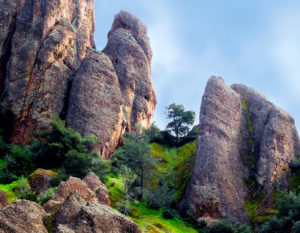Emerging from the chaparral-covered Gabalan Mountains south of Gilroy is the nation’s newest national park.
Pinnacles, upgraded from the status of “national monument,” may be best known locally for its wild rock formations and the California condor recovery program. But as of the January name change signed into law by President Obama, the 27,000-acre expanse of jutting volcanic rock is officially part of the national park circuit.
What does being the 59th national park mean? Apparently, no additional protections or funding. Rather, Pinnacles could be seeing a lot more visitors than in the past.
“The biggest change will be that more people will likely find us, especially foreign visitors,” said Nicole Andler, Pinnacles’ chief of interpretation. “When planning their vacations, they tend to look at the highlights and now that we have a national park in the name, we will be a highlight.”
While there are no estimates on projected visitor growth (in 2012 the park took in 250,000 people), other national monuments that have transformed into national parks, such as Great Sand Dunes National Park and Preserve in Colorado, have seen a 10 to 20 percent uptick in visitors, according to Andler.
In order to lessen the tourist footprint, park staff are directing visitors to places beyond the ever-popular caves and high peaks, to trails through the valley bottom and to a grassland savanna with impressive valley oaks. The park’s general management plan calls for the eventual development of a new visitors center in the park, as well as infrastructure improvements to the campground.

“We’re definitely going to keep an eye on things out there,” said Andler, adding that volunteers are scouting the park looking for signs of disturbance and tourists in need of help from the elements.
Pinnacles can be a harsh climate, especially in summer months when temperatures regularly exceed 100 degrees. Nevertheless, the park is probably the best remaining refuge for flora and fauna species endemic to the central California coast and Pacific coast range. The massive monoliths, spires, cave passages and canyons are home to 32 species holding special federal and state status, including most notably, the reintroduced California condor.
The area was formed by an extinct volcano that erupted 23 million years ago at a site 195-miles to the southeast. The San Andreas Fault split the volcano and the Pacific Plate slowly carried the site northward to its present location.
Pinnacles was established as a national monument in 1908 for the purpose of protecting its rock formations, and has seen a number of expansions over the years. Congressman Sam Farr, D-Salinas, led the effort in Congress to change the status to national park, in part, to bolster the local economy, said Farr spokesperson Adam Russell. He said the local Chamber of Commerce initially requested the redesignation to national park.
“For every dollar you invest in national parks, you get a $4 return to the local community,” Russell said.
But could all the extra attention end up harming Pinnacles? Russell said most of the park is already designated as federal wilderness, which carries the strictest level of protection on public land (Farr’s attempt to expand the wilderness area in Pinnacles was killed by Republicans in Congress).

“You can’t even build a road on it,” he said.
And park staff have reported that the park has been underutilized, meaning it has the resources to handle more tourists, Russell said.
One major mover-and-shaker who helped make the new national park happen was Ken Burns, who calls national parks “America’s best idea” in his 2009 documentary series on national parks.
“We understand … that while changing an area’s designation from ‘monument’ to ‘national park’ does not necessarily change its crucial attributes, it nonetheless alters its place in the American imagination,” Burns wrote in a letter to Congress in support of the redesignation.
April is typically high season for the park, as visitors come to admire the blanket of wildflowers and bask in milder temperatures. Let’s just hope that however many come to this newest national park, they tread lightly.
Alison Hawkes is the online editor of Bay Nature.


